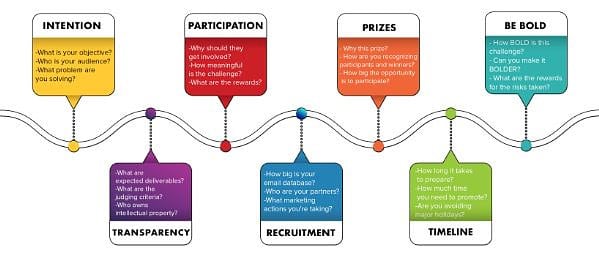Yet at an early stage many hit a roadblock: how do they actually go about creating and managing a prize challenge? We have broken the process down to a template of seven key steps.
1. Intention
Be clear on what challenge you are seeking to solve. If you don’t set clear and correct objectives at the start of the process you won’t have firm foundations to shore up later decision-making about which solution(s) to select. And also be certain of the audience(s) for whom you are seeking the solution(s). Have you consulted with them to make sure? Try to network and hear the views of as many experts as possible, they may have already gone through the same process.
At this stage, also make yourself aware of existing solutions that may claim to already be the one you seek, and identify what they lack to not be the full answer you’re searching for.
Are you searching for a solution to a challenge that’s too big, would it be better to break it down into a series of challenges that lead from one to the next? This is a good idea if different stages of solutions require different knowledge or expertise.
2. Transparency
Be sure to define the challenge you wish to resolve and not the sort of solution you may expect.
What are the deliverables? Are you looking for ideas that can be further worked on in consultation just with the providers, or maybe also with a wider pool of innovators that will require the initial providers to share their solution at an early stage? Or do you seek a prototype, or a functioning MVP (minimal viable product)?
Who will judge the solutions that are submitted? Be sure to explain their motivation and their credibility as an incentive to enter the challenge.
Be clear on who will own the Intellectual Property.
3. Participation
Make it worthwhile for teams or individuals to compete for your prize. What are you offering them as incentives? Is a prize purse enough? Or is one even necessary at all? How about offering an investment in their company, or a job with your company? Or testing in your labs?
Beyond the value of what you offer as prizes, respondents will judge the value of the challenge in its own right. Where would your challenge sit on a scale ranging from delivering a benefit for all humankind to helping a commercial enterprise bring a seemingly insignificant product to market?
Do you want to set eligibility criteria? Is your challenge focussed on students because you want to incentivise the next generation of innovators? Or startup entrepreneurs, or people within certain territories?
Keep in mind the challenge entrants will be using their own time and budgets to find a solution for you. Ask for too much and interest and participation will be low. Ask for something too obvious and you could be swamped with replies.
4. Recruitment
Be sure to communicate your challenge to the correct people. Identify appropriate skills or knowledge that are relevant or will be required. As an example, a NASA challenge to design a foldaway radiation shield targeted origami experts, not scientists.
Do you have your own databases, or do you need to go via third parties to reach them? Who can help you at this stage? Maybe there are challenge partners you should get support from in these efforts.
Will you introduce people with complementary skills to each other to form challenge teams, or do you want pre-formed teams to enter your challenge?
5. Prizes
We’ve already mentioned the value of prizes being in line with the amount of effort you’d like innovators to put in to providing you with a solution to your challenge. They will all be analysing it on a risk-to-reward ratio basis.
And maybe as well as, or perhaps even in place of a financial prize, there could be some peer group recognition. So think of how the prize(s) will be awarded. If it’s going to be at a well-attended, prestigious event to which you will invite the winners and pay their costs, then that starts to put you higher on a list of challenges to bother with.
Will there be interim prizes, perhaps for an initial shortlist of five submissions, then two, then a final play-off? And at each stage you could provide more information and ask them to develop their solution to a next stage.
Could they be interviewed to feature in online or offline media coverage – something with links that they can use to spread the news among their own networks and other peer groups?
Is there something you could offer that money can’t buy? Over to you to be imaginative!
6. Timeline
Allow enough time consistent with the deliverables you have set. Ideas are quicker to submit than a prototype or an MVP. Though don’t allow so much time that people will delay a decision to take part and be involved. In that time, another prize challenge may catch their eye.
While a challenge is open, make sure that you or appropriate colleagues are going to be available for any would-be solution providers to come to with questions, for more information, for confirmation of any possible ambiguities, or whatever.
7. Be Bold
An open innovation challenge is an opportunity, and a means, to arrive at innovative breakthroughs rather than incremental improvements to an existing status quo. So go for a 10x rather than a +10% solution.
A final check
At the end of your planning, don’t forget the SMART acronym and apply it to your open innovation prize challenge. Is it Specific enough (without being unduly restrictive); will results be Measurable; is it Achievable, and not an issue that has dogged your industry for years; are you being Realistic with what you want and what you’re offering; and is your Timeline reasonable?
You are not alone
It’s always good to have someone with you when you’re on a learning curve. If you want to learn more, receive guidance or just have someone to discuss your plans and ideas with, you can contact our Hyperloop Innovation dedicated team to help in designing your prize challenge.





0 Comments